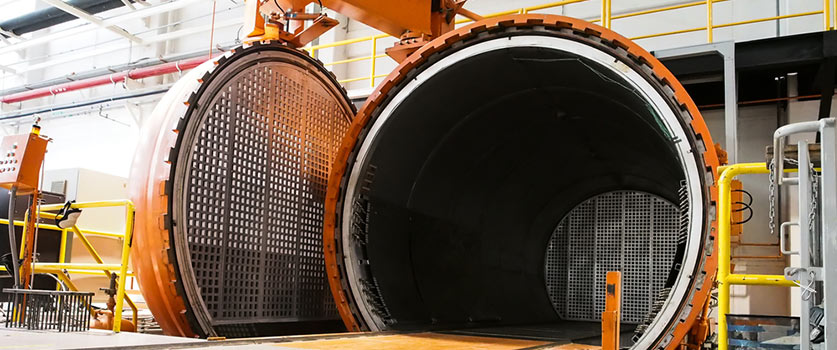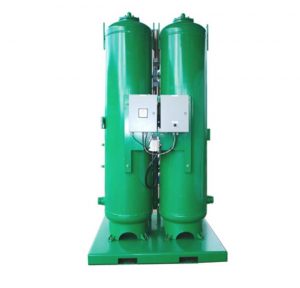Using Nitrogen Gas in the Curing Process for Products
June 16, 2020
The success of many industrial processes is dependent on the ability of plant operators to finely regulate the physical and chemical conditions under which manufacturing occurs. Applications across oil and gas, brewery, metallurgy, and food manufacturing require certain temperatures and atmospheric conditions to yield high-quality finished products.
Maintaining the right temperatures and atmospheric conditions usually means strictly regulating the amount of air moisture and oxygen content. Nitrogen gas curing provides a suitable solution in these cases as the gas possesses the right physical and chemical properties required to maintain an optimal environment.
In this article, we consider the effectiveness of using nitrogen in industrial curing processes.
How Does an Autoclave Work in the Curing Process?

The industrial use of autoclaving procedures is integral to manufacturing. Forged components are subjected to elevated temperatures and pressures within autoclave chambers to achieve an even formation.
The autoclave curing process typically involves the following stages:
- Loading
- Pressure application
- Progressive temperature elevation
- Timed component soak at a stable temperature
- Vessel cooling
- Chamber depressurization
What Are the Dangers Associated with Industrial Scale Autoclaving?
The elevated temperatures and pressure at which industrial components are cured places them at significant risk of spontaneous combustion in the presence of oxygen. Without applying an inerting agent such as nitrogen, the increased risk of industrial fires can jeopardize employee safety.
Why Is an Inert Gas Used in the Curing Process?
Inerting gases play a critical role in stabilizing the environment within an autoclave chamber used in curing industrial components. Inerting gases inhibit spontaneous combustion by driving out volatile gases from within the chamber.
For example, nitrogen creates an oxygen-deficient atmosphere that is stable even at the elevated temperatures and pressures under which autoclaves operate.

Why Nitrogen Is an Ideal Gas for Product Curing
Nitrogen gas is frequently used in product curing due to its suitable physical and chemical properties. Perhaps more importantly, nitrogen gas is easy to source as it constitutes a significant portion of atmospheric air. An on-site nitrogen generator can easily produce large quantities of nitrogen.
Advantages of Nitrogen Use in Product Curing
The following are some benefits of using nitrogen gas in the curing process:
Decreased Risk of Spontaneous Combustion
Gaseous nitrogen is very stable and non-reactive which makes it ideal for processes where there is an increased risk of combustion. Applying nitrogen gas to a curing system will create an oxygen negative environment, thereby inerting the system and minimizing the risk of fire.
Non-reactivity
Due to its stable chemical properties, nitrogen gas is unreactive. This characteristic is highly desirable in most industrial processes where cross-reactions with applied gases might alter the final product.
Low Utility Costs
Nitrogen is a relatively inexpensive gas to purchase as it is readily available in air and easy to extract, transport and store. Depending on the scale of their industrial production, plant operators can opt between routine supply and storage or on-site generation of the required quantities of the gas.
How Is Nitrogen Generated Used in Product Curing?
The nitrogen gas utilized in various product curing procedures can be generated using one of three nitrogen production methods:
- Membrane nitrogen generation
- Pressure swing adsorption
- Fractional distillation
All the above-listed methods can be used to generate high purity nitrogen gas useful for inerting across a wide range of industrial processes.
Membrane Nitrogen Generation
In this technique, specialized membranes with selective permeability are used to separate a stream of air directed through them, into its component gases. The basic working principle of separation here is the variable speed of travel of the gas fractions through the semi-permeable membranes. Membrane nitrogen generators achieve a rapid rate of adsorption due to the wide surface area of the membranes applied.
A typical membrane nitrogen gas generation unit is composed of coalescing filter, carbon filter, particulate filter, an optional immersion heater, and polymeric membrane.
Pressure Swing Adsorption
Pressure swing adsorption is a two-stage process where adsorbent materials are used to achieve the separation of a gaseous mix. The generation of nitrogen is done via two processes that run simultaneously:
- Adsorption
- Desorption
Adsorption requires a stream of the gas mix to be passed through an adsorptive tower containing molecular sieve materials. These materials selectively retain oxygen while allowing nitrogen to flow through to a collecting unit. This simple process will be repeated until the adsorptive material in the tower reaches its saturation point.
The process of desorption occurs simultaneously in a second tower containing the same materials as the adsorptive tower. The difference here is that rather than adsorbing oxygen, the sieve material actively releases the retained oxygen to regenerate itself for another cycle of nitrogen generation.
PSA nitrogen generators typically require two generating towers – one in each phase of the cycle being switched intermittently.
Fractional Distillation
This nitrogen generation technique yields the highest purity gas by supercooling air below its liquefaction point and then distilling out its component gases. Fractional distillation typically yields nitrogen gas of approximately 99.999% purity. However, this method is among the most expensive ways to generate nitrogen.
Example of a GENERON® Nitrogen Generator for Autoclave-Polymer Curing

GENERON, a leader in the design and supply of Nitrogen Generators; Membrane and Pressure Swing Adsorption (PSA) Systems, is pleased to announce that another GENERON® PSA Nitrogen Generator system has been manufactured and delivered to our Colorado Distributor, Blackhawk Equipment, located in Arvada, CO.
This GENERON® PSA Nitrogen Generator System, Model NS-24-85-115, will provide 9,000 scfh of High Purity Nitrogen, used for filling a 5,575 cubic foot Industrial Autoclave to 90 psig, for the purpose of curing polymer panels.
To complement the GENERON® system, Houston Vessel Manufacturing, an affiliated IGS company, supplied two 12,000 gallon high-pressure vessels used for this system.
GENERON Has Efficient On-site Nitrogen Generation Solutions
In the last four decades, GENERON has remained dedicated to providing its clients with top quality nitrogen and oxygen generation solutions. Our services are targeted at achieving maximal industrial productivity while remaining cost-effective.
Contact our team online today for more information about using our on-site generation solutions for your product curing process.
